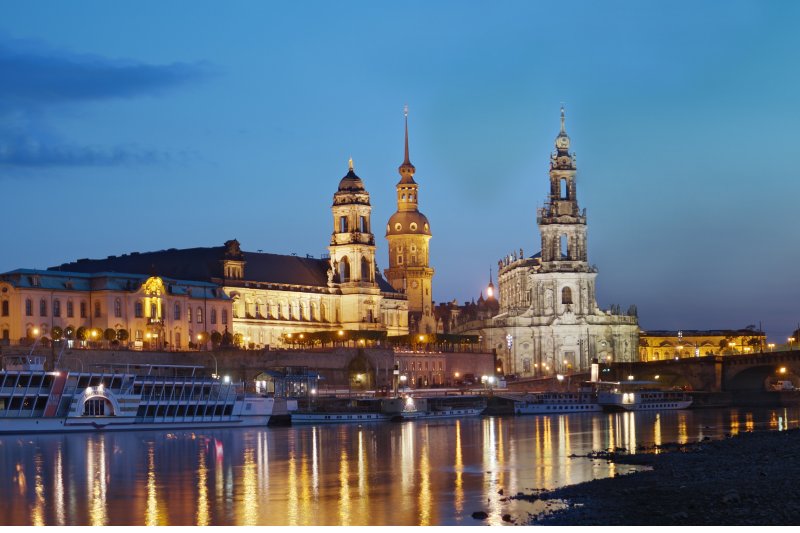 Dresden at night, Germany
Dresden at night, GermanySource: https://commons.wikimedia.org/wiki/File:Dresden-nightpanorama-dri.jpg
Author: Kolossos

Dresden (Czech: Drážďany; Polish: Drezno) is the capital of the Free State of Saxony in Germany. It covers 328.8 sq km (127 sq mi) and has a population of 523,000 (2011 estimate), within a metropolitan area of 1.1 million people.
Dresden is within the eponymous administrative region (Direktionsbezirke), which covers 7,931 sq km (3,062 sq mi) and has a population of 1.6 million people. It is one of the three administrative regions of Saxony, and comprises the districts (Kreise) of Bautzen, Gölitz, Meißen and Sächsiche Schweiz-Osterzgebirge, as well as the city itself, which is a "district-free town". The city is in a valley of the River Elbe, near the border with the Czech Republic on the eastern part of Germany.
Dresden is located within the Dresden Basin with the Ore Mountains to the south and the Elbe Sandstone Mountains to the east. The highest point within Dresden itself reaches 384 meters. The city is regarded as one of the greenest cities in Europe, with 63% of the city area still covered by green expanses or are forested.
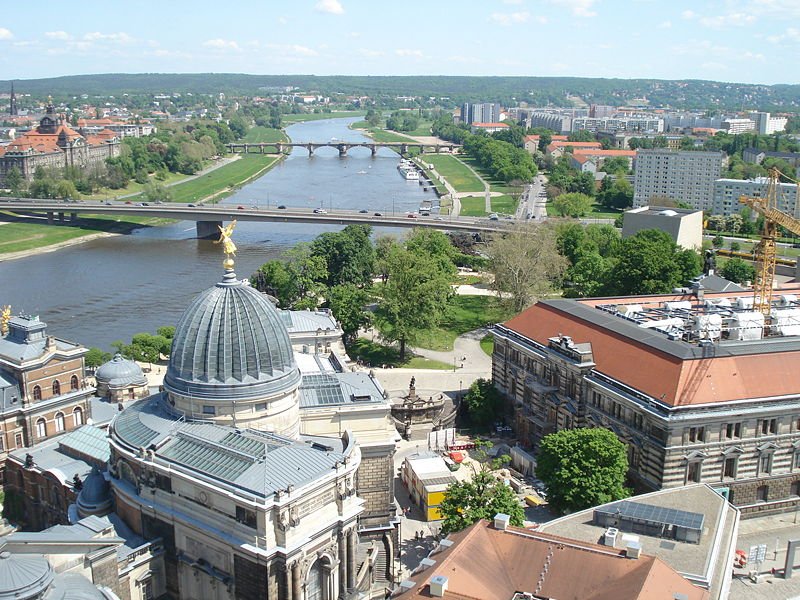 View of Dresden
View of DresdenSource: https://commons.wikimedia.org/wiki/File:Dresden_%C3%9Cberblick_4.jpg
Author: Kay Körner

Dresden experiences a cold-moderate to continental climate. The warmest months are July and August, when the average high temperature reaches 22°C (72°C). Coldest month is February, when the average low temperature drops to -3°C (27°F). July is by far the wettest month of the year, receiving 150 mm (5.91 in) of rain, equivalent to almost a quarter of the annual precipitation.
The area around Dresden has a long history of human habitation. The Linear Pottery culture tribes lived there around 7,500 BC. The earliest mention of the city may have occured in the late 12th century. Ancient texts refer to an Antiqua Dresdin or Altendresden, both meaning Old Dresden, as having existed since 1350.
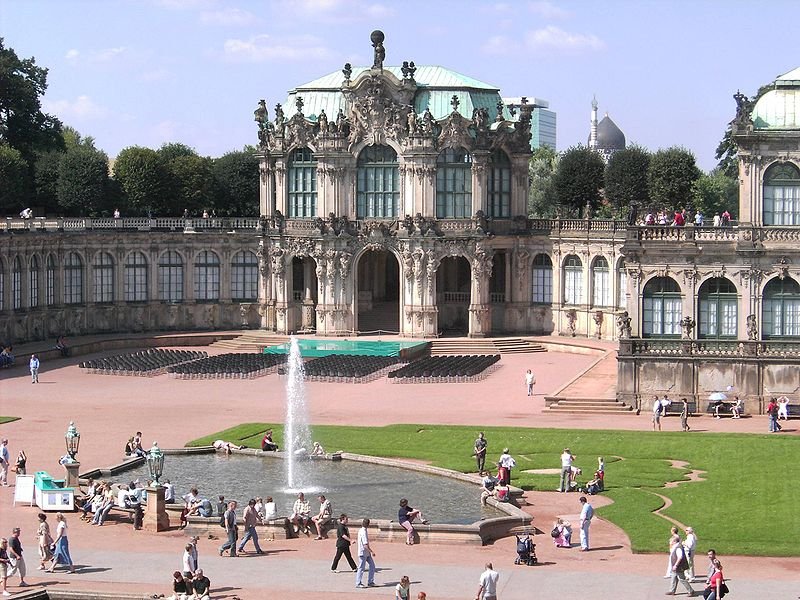 The courtyard at the Zwinger in Dresden
The courtyard at the Zwinger in DresdenSource: https://commons.wikimedia.org/wiki/File:Dresden-Zwinger.courtyard.07.JPG
Author: Ingersoll

Dresden became the capital of the Kingdom of Saxony between 1806 and 1918. It entered the 20th century as a leading European center of classical music, culture and science. Unfortunately the city was totally destroyed during the massive bombing on 13 February, 1945 carried out by the British Royal Air Force and the US Army Air Force, killing as many as 25,000 people (though the Nazis published death tolls of 200,000). Strangely however, Dresden has a whole military borough, called Albertstadt, which was never targeted during the bombing campaign.
After the war, Dresden found itself on the eastern side of the Iron Curtain. It became an industrial city within the German Democratic Republic. Many of its historic buildings were rebuilt. Large parts of the city however took on the Socialist Modern architectural style. Compared to cities in West Germany, many of Dresden's churches, royal buidings and palaces were never rebuilt.
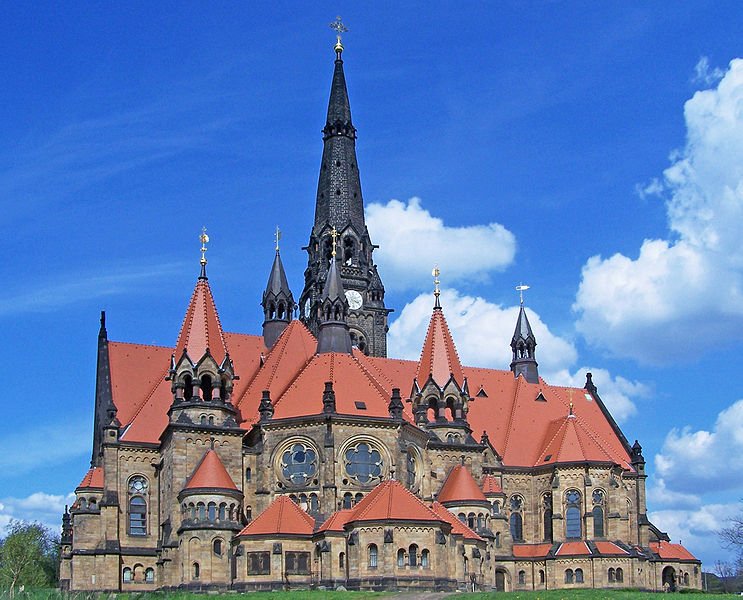 Garnisonkirche, Dresden
Garnisonkirche, DresdenSource: https://commons.wikimedia.org/wiki/File:Dresden_Garnisonkirche_3c.jpg
Author: X-Weinzar, Waugsberg

Dresden became part of the Federal Republic of Germany following Reunification, which heralded a new age of reconstruction. Even during Reunification, the city still bear scars inflicted during the Second World War. Post-reunification era saw a number of the city's historic buildings reconstructed, particularly as the city approaches its 800th anniversary in 2005.
However, even as Dresden rushes to modernize itself, it found itself up against UNESCO over its decision to build a bridge, the Waldschlösschenbrücke, across the Dresden Elbe Valley in which the city is located. Inscribed in 2004, the valley was placed on the list of Endangered World Heritage Site in 2006 with UNESCO threatening to delist the site should the bridge be built.
A public referendum a year earlier had voted for the bridge. When the state high court ruled in favor for the bridge - a ruling described by the Vice President of the German parliament Wolfgant Thierse as "a sad day for Germany". In 2009, the World Heritage Commission voted to remove the World Heritage status for the Dresden Elbe Valley, making it the only European site to ever be delisted.
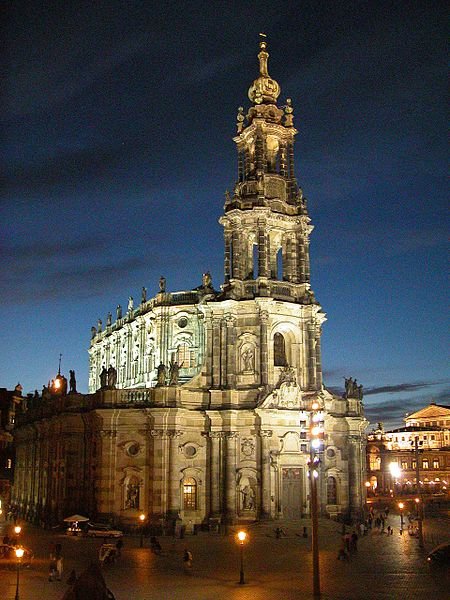 Hofkirche, presently the Catholic Cathedral of Dresden
Hofkirche, presently the Catholic Cathedral of DresdenSource: https://commons.wikimedia.org/wiki/File:Dresden_Hofkirche_abends_%282005%29.jpg
Author: Brunswyk

Visiting Dresden
You can fly to the Dresden-Klotzsche Airport (DRS), located on the northern part of the city. From the airport, you can take a public bus (77 or 97), tram or local train to reach the city center. Apart from major cities in Germany, the airport also has flights connecting it to Moscow, Zürich and Vienna.Places of Interest in Dresden
- Albertinum
Originally the royal arsenal, the Albertinum today houses a collection of contemporary artwork. - Blaues Wunder
The suspension bridge spanning the River Elber built in 1891-3. - Brühlsche Terrasse
Formerly a fortification protecting the city, the terrace waslater turned into a magnificent garden. - Frauenkirche
A huge church originally built in 1726-43, was completely destroyed by Allied bombing, was reconstructed in 1993. - Fürstenzug
A magnificent 110-yard long frieze on the Langer Gang, a very long building erected in 1586-91. - Gemäldegalerie Alte Meister
The Gallery of Old Masters in Dresden showcases some of the finest paintings in Europe. - Goldene Reiter
Gilded equestrian statue of Augustus the Strong, created by Jean Joseph Vinache in 1736. - Großer Garten
A park, called the Great Garden, dating back to the 17th century. - Hofkirche
Baroque royal church, now serving as the Cathedral of Dresden. - Japanisches Palais
Originally called the Dutch Palace, it was renamed the Japanese Palace when it was intended to house Augustus the Strong's collection of Japanese porcelain - though the porcelain were never housed there. - Karl-May-Museum
Museum in Radebeul, five km nothwest of Dresden, devoted to the life and work of the author Karl May. - Kraszewski-Museum
Museum devoted to the works of Polish writer Jozef Ignacy Kraszewski who settled in Dresden in 1853. - Kreuzkirche
Baroque/Neo-Classical church originally built in 1764-92 was severely damaged during World War II, and left partially unrestored, to commemorate the bombing during the war. - Museum für Sächsische Volkskunst
Housed in the former Renaissance hunting lodge is the Museum of Saxon Culture. - Neues Rathaus
The new massive town hall, in the Neo-Renaissance style. - Pfunds Molkerei
Old dairy from the 19th century in the new town part of Dresden. - Residenzschloss
Former residence of the Wettin family today houses some of the most treasured artworks in eastern Germany. - Sächsische Staatsoper
The Saxony State Opera House is a Neo-Renaissance building reconstructed after the Second World War, and only completed in 1985. - Schinkelwache
A small, beautiful Neo-Classical building by Karl Friedrich Schinkel built in 1830. - Schloss Pillnitz
The summer residence of Augustus the Strong built in 1720-23. - Verkehrsmuseum
Transportation museum housed in the Johanneum , the 16th century Renaissance building originally built for the royal stables. - Zwinger
The most beautiful Baroque structure in Dresden, commissioned by Augustus the Strong and built in 1709-32.
 Latest updates on Penang Travel Tips
Latest updates on Penang Travel Tips

Copyright © 2003-2025 Timothy Tye. All Rights Reserved.

 Go Back
Go Back